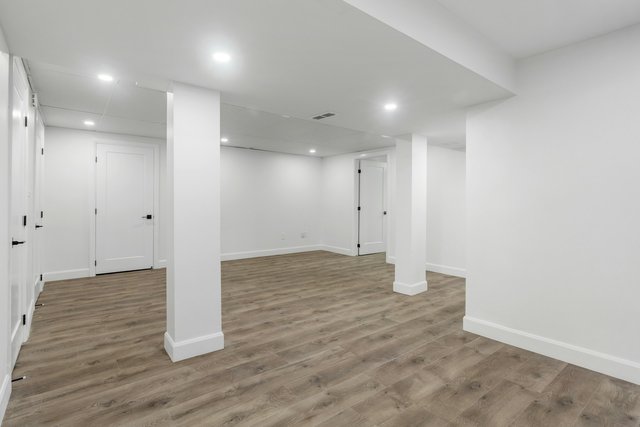Why Is Interior & Exterior Basement Waterproofing Necessary?
Basements are susceptible to water infiltration, which can lead to a myriad of issues such as mold growth, structural damage, and compromised indoor air quality. Waterproofing your basement, both internally and externally, is crucial to safeguarding your home against these potential hazards. In this article, we delve into the significance of interior and exterior basement waterproofing, highlighting their respective benefits, processes, and cost considerations.
Understanding Basement Waterproofing

What is Basement Waterproofing?
Basement waterproofing, often conducted by professionals like Aquamaster Plumbing, entails the utilization of diverse techniques and materials aimed at thwarting water penetration into the foundation walls and basement floor. This protective approach serves to maintain the basement's dryness and safeguard it against issues stemming from excess moisture.
Types of Basement Waterproofing
There are two primary types of basement waterproofing: interior and exterior. Interior waterproofing focuses on managing water that has already penetrated the basement, while exterior waterproofing prevents water from entering the basement in the first place.
Importance of Interior Basement Waterproofing
Interior basement waterproofing plays a crucial role in maintaining a dry and healthy environment within the basement. Here are some reasons why it is necessary:
Prevents Water Damage
Interior waterproofing systems, such as interior drainage systems and sump pumps, help to channel water away from the basement, preventing it from causing damage to the interior structure and belongings.Preserves Property Value
A waterproofed basement adds value to your property by protecting it from water-related issues that could diminish its resale value. Potential buyers are more likely to be attracted to a home with a dry and well-maintained basement.Enhances Indoor Air Quality
By preventing moisture buildup and mold growth, interior waterproofing contributes to better indoor air quality, reducing the risk of respiratory problems and allergies among occupants.
Benefits of Exterior Basement Waterproofing
Exterior basement waterproofing is equally important for safeguarding the foundation and structural integrity of a building. Here are some advantages:
Protects Foundation
Exterior waterproofing prevents water from reaching the foundation walls, reducing the risk of cracks, erosion, and other forms of structural damage caused by water infiltration.Prevents Structural Damage
By keeping the soil surrounding the foundation dry, exterior waterproofing helps to prevent the expansion and contraction of soil, which can exert pressure on the foundation walls and lead to cracks and shifting.Improves Energy Efficiency
A waterproofed exterior foundation reduces the likelihood of moisture entering the basement, which can contribute to energy loss through air leaks and dampness. This, in turn, helps to improve the energy efficiency of the building.
Comparison: Interior vs. Exterior Waterproofing
When deciding between interior and exterior waterproofing, several factors should be considered, including cost, effectiveness, and aesthetics.
Cost
Interior waterproofing is generally more affordable than exterior waterproofing, as it involves less labor and materials. However, the cost-effectiveness of each method depends on the specific needs and conditions of the property.Effectiveness
While both interior and exterior waterproofing methods are effective in preventing water infiltration, exterior waterproofing provides superior protection by addressing the problem at its source, outside the foundation walls.Aesthetics
Interior waterproofing systems are typically installed inside the basement, where they may be visible and take up space. Exterior waterproofing, on the other hand, does not affect the interior aesthetics of the basement.
Signs You Need Basement Waterproofing
It's essential to be aware of the signs that indicate the need for basement waterproofing. Some common indicators include:
Visible Water Seepage
If you notice water seeping through cracks in the walls or floors of your basement, it's a clear sign that waterproofing measures are needed to prevent further damage.Musty Odors
The presence of musty or moldy odors in the basement could indicate excess moisture and poor ventilation, signaling the need for waterproofing to address the underlying issue.Cracks in Walls or Floors
Cracks in the foundation walls or floors can provide entry points for water, compromising the structural integrity of the basement. Waterproofing helps to seal these cracks and prevent further damage.
Professional Basement Waterproofing Process
When hiring a professional basement waterproofing contractor, the process typically involves the following steps:
Assessment and Inspection
The contractor will conduct a thorough assessment of the basement to identify any existing water issues and determine the most suitable waterproofing solutions.Choosing the Right Waterproofing Method
Based on the assessment findings, the contractor will recommend the appropriate interior and/or exterior waterproofing methods to address the specific needs of the property.Installation Process
Once the waterproofing plan is finalized, the contractor will proceed with the installation of the chosen waterproofing systems, ensuring proper implementation and adherence to industry standards.
DIY Basement Waterproofing Tips
While professional waterproofing is recommended for optimal results, there are some DIY measures homeowners can take to mitigate water infiltration in their basements:
Maintaining Gutters and Downspouts
Regularly clean and inspect gutters and downspouts to ensure proper drainage away from the foundation walls, preventing water buildup around the basement.Sealing Cracks and Gaps
Use waterproof sealants or epoxy injections to seal any cracks or gaps in the foundation walls or floors, preventing water from seeping into the basement.Installing Exterior Drainage Systems
Consider installing exterior drainage systems, such as French drains or curtain drains, to divert water away from the foundation and prevent moisture buildup in the soil.